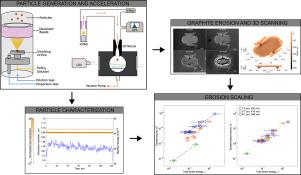Surface erosion rates of graphite from high-speed solid particle impacts
IF 6.1
1区 工程技术
Q1 ENGINEERING, MECHANICAL
引用次数: 0
Abstract
Aerospace vehicles are highly susceptible to damage from particle-laden flows; such encounters can lead to high-speed impacts from airborne particles such as dust, sand, and other particulate matter. We have characterized the rate of graphite surface erosion from the impact of monodisperse ferrous sulfate particles ranging in diameter (1.8 m, 3.7 m, and 6.1 m) at different impact angles (90°, 75° and 45°) and variable impact velocities (). Measurements were carried out by generating particles at known number densities, and accelerating them via a converging–diverging nozzle to impact on graphite substrates, positioned at variable angles relative to the flow direction. Laser Doppler velocimetry was used to characterize particle velocities prior to impact. Measurements reveal that impact angle had a minimal effect on erosion rate. The eroded volume increased with total kinetic energy of the impacting particles, integrating over the entire experimental time. We develop empirical expressions linking eroded volume, erosion rate, and erosion propagation velocity to the velocity and size of the particles. The increase in surface roughness as erosion progressed is also quantified. In total, measurements yield an erosion rate model for graphite which may be used to predict rates of surface removal for graphite surfaces exposed to solid particles impacting at transonic to supersonic speeds.

高速固体颗粒撞击对石墨表面的侵蚀速率
航空航天飞行器极易受到颗粒流的破坏;这样的相遇会导致空气中的尘埃、沙子和其他颗粒物质的高速撞击。我们表征了直径为1.8 μm、3.7 μm和6.1 μm的单分散硫酸亚铁颗粒在不同冲击角度(90°、75°和45°)和不同冲击速度(340 ~ 520ms−1)下对石墨表面的侵蚀速率。测量的方法是产生已知密度的粒子,并通过一个会聚-发散喷嘴加速它们,使它们以相对于流动方向的不同角度撞击石墨基板。激光多普勒测速仪用于表征撞击前的粒子速度。测量结果表明,冲击角对侵蚀速率的影响微乎其微。侵蚀体积随着冲击粒子的总动能的增加而增加,在整个实验时间内进行积分。我们开发了将侵蚀体积、侵蚀速率和侵蚀传播速度与颗粒的速度和大小联系起来的经验表达式。随着侵蚀的进展,表面粗糙度的增加也被量化。总的来说,测量产生了石墨的侵蚀速率模型,该模型可用于预测石墨表面暴露于固体颗粒以跨声速到超音速撞击时的表面去除率。
本文章由计算机程序翻译,如有差异,请以英文原文为准。
求助全文
约1分钟内获得全文
求助全文
来源期刊

Wear
工程技术-材料科学:综合
CiteScore
8.80
自引率
8.00%
发文量
280
审稿时长
47 days
期刊介绍:
Wear journal is dedicated to the advancement of basic and applied knowledge concerning the nature of wear of materials. Broadly, topics of interest range from development of fundamental understanding of the mechanisms of wear to innovative solutions to practical engineering problems. Authors of experimental studies are expected to comment on the repeatability of the data, and whenever possible, conduct multiple measurements under similar testing conditions. Further, Wear embraces the highest standards of professional ethics, and the detection of matching content, either in written or graphical form, from other publications by the current authors or by others, may result in rejection.
 求助内容:
求助内容: 应助结果提醒方式:
应助结果提醒方式:


